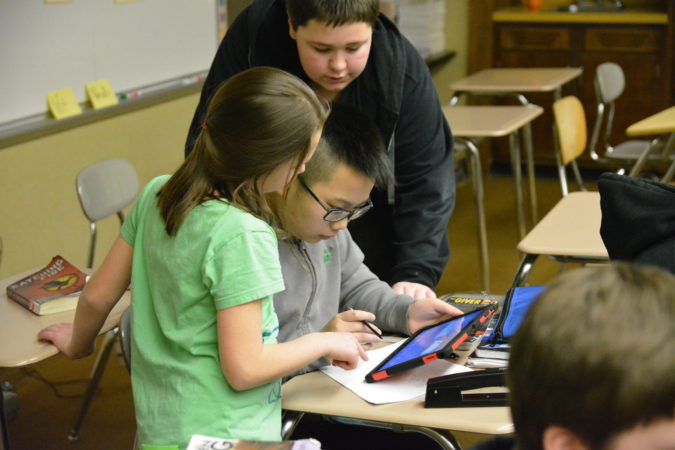
[/vc_column_text]
[/vc_column][vc_column width=”1/2″][vc_row_inner][vc_column_inner width=”1/6″][/vc_column_inner][vc_column_inner width=”1/6″][vc_column_text]ABOUT
[/vc_column_text][/vc_column_inner][vc_column_inner width=”1/6″][vc_column_text]
VIL SCHOOLS
[/vc_column_text][/vc_column_inner][vc_column_inner width=”1/6″][vc_column_text]
STEM
[/vc_column_text][/vc_column_inner][vc_column_inner width=”1/6″][vc_column_text]
MOBILE ACCESS
[/vc_column_text][/vc_column_inner][vc_column_inner width=”1/6″][/vc_column_inner][/vc_row_inner][/vc_column][/vc_row][vc_row][vc_column width=”1/1″][vc_column_text]Over the next month, every student and teacher in eight schools across the country will receive a tablet equipped with a two-year, 5-GB monthly data plan, donated by Verizon to Digital Promise.
For the students and parents of these schools, the journey may feel like it is just beginning. For the district staff, principals, coaches, and teachers at these schools, this is just one milestone along a much longer expedition. Back in May and June, all of the schools committed to working through a process to ensure their learning environments would be ready for the new technologies.
To make certain we were supporting these schools the best we could, we considered: What makes a school ready?
How do we know when the teachers are ready to use these tools to enhance their teaching? How do we know when students are ready to be responsible and safe with these new tools? How do we know when parents are ready to commit to this new vision of learning?
To answer these questions, we looked at the innovations and success occurring in the League of Innovative Schools, and referred to frameworks such as the ISTE Essential Conditions and Project RED.
By piecing all of these frameworks (and many more!) together, we stumbled upon three distinct phases of readiness that a school needed to work through before the teachers or the students even touched a tablet.
Phase 1: “Ready to Commit”
A school that is “Ready to Commit” is eager to provide students with authentic learning opportunities that build student aspirations and the skills needed to survive in a global economy. All stakeholders are committed to this transformation, and results are achieved through shared leadership, strategic planning, and aligned resources.
At the Vista Innovation and Design Academy (VIDA) in Vista, California, committing to this tablet implementation was a natural step. Over the last year, Principal Eric Chagala and the school staff have been hard at work planning their magnet school launch with a design-focused philosophy of teaching and learning.
According to one of VIDA’s Digital Learning Coaches, David Ruiz, the “tablets are well matched to our innovative approach to teaching.”
“We have chosen to place Design Thinking and Project-Based Learning at the center of our pedagogy,” he says. “In both of these teaching approaches, one of the expectations is that time spent in class be used in collaboration with peers to create products addressing real world problems.
Our students’ tablets will allow them to come to class prepared with whatever digital material a teacher has assigned or a student has discovered through their own research.”
Phase 2: “Ready to Deploy”
A school that is “Ready to Deploy” devices has the policies and infrastructure in place to support equitable access for all students. Precautions have been taken so that all learners can use tools and resources safely at all times. Support structures are in place so that learners are not disrupted in the use of the devices and IT staff can efficiently manage upgrades and fixes.
At Carroll Middle School in Raleigh, North Carolina, making sure these devices were ready to manage fell on both the technology services team and the instructional technology team.
“The big concern for rolling out to teachers really was the process,” says Kevin Harvey, Instructional Technology Coordinating Teacher for STEM and Global Programs at Wake County School District. “We knew the devices would need to be more secure but less restricted, so our tech services staff worked to define exactly what needed to happen from unboxing to use.
“Then we determined which steps we could do for teachers (encrypting the device, charging) and which steps they needed to do for themselves (signing into their Google Accounts). By planning that part carefully, we saved teachers a lot of time and learned a lot that we can apply to the student roll out later on.”
Phase 3: “Ready to Transform”
A school that is “Ready to Transform” encourages ongoing communication and reflection with all stakeholders involved in the project. Professionals are supported with flexible, ongoing learning opportunities. Parents are engaged in ongoing discussions about the shifting learning experiences. Students take leadership roles in their classrooms, schools, and community.
For Regina Colquitt at Chute Middle School in Evanston, Illinois, this initiative has raised some interesting conversations with parents.
“I’ve answered my share of emails and basic conversations regarding how much students will be using their iPads during the day, and then how much will they need them at night,” she says. Families sent her a New York Times article about Steve Jobs and his family’s use of tech at home. She realized that readiness is very much a parenting conversation, that she herself needs to make sure her children are having varied experiences.
“In the world we live in, it’s imperative to stop, pause and allow time to be together, to relax, and to disconnect,” Colquitt says. “However, I’m aware of the 21st-century skills my children will need to be successful in the future. In the end, it’s about balance. Both home and school play an important role in the lives of our children.”
We’ll be sharing more details about the processes these schools and leaders went through to prepare for the rollouts. Sign up here for updates on Digital Promise Schools![/vc_column_text][/vc_column][/vc_row]

We want to hear from you!
Please take this 5-minute survey and help us serve you better.
